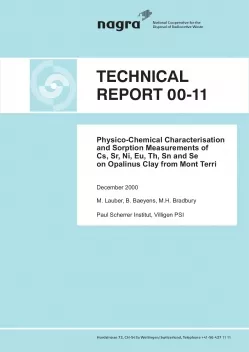
Technical Report NTB 00-11
Physico-Chemical Characterisation and Sorption Measurements of Cs, Sr, Ni, Eu, Th, Sn and Se on Opalinus Clay from Mont Terri
Opalinus Clay is currently under investigation as a potential host rock for the disposal of high level and long-lived intermediate radioactive waste.
A throughout physico-chemical characterisation was carried out on a bore core sample from the underground rock laboratory Mont Terri (Canton Jura). The results of these investigations indicate that the major characteristics (mineralogy, cation exchange capacity, cation occupancies, selectivity coefficients, chloride and sulphate inventories) were very similar to a different core sample, previously used for porewater modelling studies. It was concluded that the porewater compositions derived in the earlier studies were reliable and could be used in this work. The organic matter which dissolved from the Opalinus Clay rock was not humic or fulvic acids and the concentration remaining in the liquid phase in the sorption experiments was < 0.5 ppm C. The organic matter is therefore considered to have little or no influence on the sorption behaviour of the studied radionuclides. Redox potential measurements of the Opalinus Clay/synthetic porewater system inside the glove boxes indicated anoxic conditions.
The main focus of the experimental work presented here is on the sorption behaviour of Cs(I), Sr(II), Ni(II), Eu(III), Th(IV), Sn(IV) and Se(IV) on Opalinus Clay equilibrated with synthetic porewaters at pH 6.3 and ~ 8. Sorption isotherms were measured for Cs, Ni, Eu, Th and Se. Single point data were measured for Sr and Sn. For all radionuclides studied the sorption kinetics were measured first. The times required to complete the sorption on the Opalinus Clay varied between one day for Th and one month for Ni and Se. Within the concentration ranges under study the uptake of Cs, Ni, Eu and Se on Opalinus Clay was non-linear, whereas for Th a linear sorption behaviour was observed. For Ni, Eu and Th the sorption increased with increasing pH. For Cs a pH independent sorption behaviour was observed. The concentration dependent uptake of Cs was modelled. The important role of background elements in the sorption experiments is discussed, particularly, in the case of Cs and Ni the lowest equilibrium concentrations were entirely determined by the natural background concentrations.
The results from the investigations presented in this work provided important data sets for the development of a sorption data base required for performance assessment studies of a potential repository in Opalinus Clay. The broad based pool of sorption data generated from this work will provide key data sets for subsequent mechanistic modelling.
